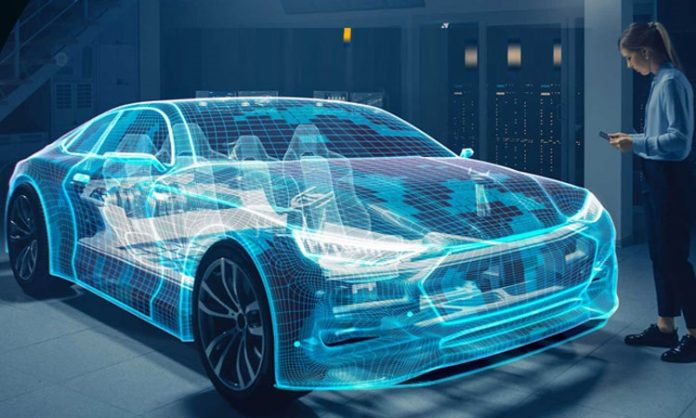Detroit Engineered Products (DEP) is a global Engineering Solutions and Product Development company with a rich 25-year legacy. Since its inception in 1998 in Troy, Michigan, USA, DEP has expanded its footprint with eight offices across Europe, China, Korea, Japan, Canada, and India.
DEP specializes in Computer-Aided Engineering (CAE) software, a crucial tool that has revolutionized product design, innovation, and optimization. This transformative technology allows companies to simulate and visualize complex scenarios, predict outcomes, and make informed decisions while conserving time and resources.
Central to DEP’s innovation is its proprietary software platform, DEP MeshWorks. This CAE-driven platform enables rapid concept CAE and CAD model generation, parametrization of CAE models, optimization, advanced meshing, and CAD morphing. DEP MeshWorks has accelerated and transformed the product development process, resulting in several creative solutions to many clients’ challenges, providing significant value and enhancing engineering outcomes.

Rashi Bajpai, Sub-Editor at ELE Times spoke with Mr Radha Krishnan, President and Founder, of Detroit Engineered Products (DEP) on the technological advancements in the automotive and EV sector.
This is an excerpt from the conversation.
ELE Times: How do you see CAE’s role evolving in the automotive industry, particularly with the increased emphasis on electric vehicles and self-driving technology?
Mr Krishnan: I foresee CAE’s role evolving dramatically with the growing emphasis on electric vehicles (EVs) and self-driving technology. CAE will become even more indispensable in optimizing the complex systems inherent to EVs, such as battery management, thermal performance, and electric drivetrains. It will enable engineers to simulate and refine designs for efficiency, range, and safety, crucial in overcoming the unique challenges of EV propulsion.
Moreover, in the realm of self-driving technology, CAE will play a pivotal role in simulating sensor integration, validating autonomous algorithms, and ensuring vehicle safety under various operating conditions. This technology will help predict and mitigate risks associated with autonomous vehicles, thereby accelerating their development and deployment. Overall, CAE’s evolution will be instrumental in driving innovation towards sustainable, intelligent mobility solutions.
It will empower automotive companies to design and deliver advanced vehicles that not only meet but exceed the performance, safety, and efficiency expectations of tomorrow’s automotive landscape
ELE Times: How well does your CAE software integrate with automotive design processes? Can you explain how your tools help design and engineering teams collaborate more effectively?
Mr Krishnan: DEP MeshWorks integrates seamlessly with automotive design processes, enhancing collaboration and efficiency throughout the product development lifecycle. Our software’s robust toolsets are specifically tailored to address the complex needs of automotive engineering, from initial concept through to detailed analysis and optimization.
Firstly, MeshWorks facilitates collaboration by providing a unified platform where design and engineering teams can work together seamlessly. Our inbuilt modules for concept CAE and CAD model generation enable rapid iteration and evaluation of design alternatives, empowering teams to make informed decisions early in the development cycle. This iterative process is crucial for refining designs and achieving optimal performance and reliability.
Secondly, the advanced meshing and morphing capabilities in MeshWorks ensure that engineers can create high-quality meshes quickly, which are essential for accurate simulations and analyses. By automating these processes, our software reduces manual effort and minimizes errors, thereby improving overall productivity.
Furthermore, MeshWorks supports process automation across various stages of product development, from pre-processing to post-processing. This automation not only accelerates workflow but also enhances consistency and repeatability in engineering tasks.
Additionally, our platform’s AI/ML algorithms enhance predictive capabilities, enabling engineers to anticipate design challenges and optimize solutions proactively. This predictive capability is particularly valuable in the automotive industry, where stringent performance and safety standards must be met.
Overall, DEP MeshWorks is designed to optimize collaboration and efficiency within automotive design teams. By streamlining workflows, automating processes, and integrating advanced technologies, we empower engineers to innovate rapidly and develop cutting-edge products that meet market demands efficiently.
ELE Times: What recent innovations in CAE technology has your company developed that are specifically for the automotive industry? How do you stay ahead of the R&D curve in this rapidly changing field?
Mr Krishnan: DEP has recently developed several innovations tailored to meet the evolving needs of electric vehicles (EVs) and artificial intelligence (AI) applications in automotive engineering. One of our key innovations is an advanced simulation toolset for EV battery systems. This includes precise thermal management simulations that optimize battery performance and lifespan, crucial for enhancing range and reliability in electric vehicles. Additionally, we have enhanced our capabilities in electric drivetrain simulation, focusing on motor efficiency and control strategies to maximize energy utilization.
In the realm of AI, we work with predictive maintenance models and adaptive control strategies, which are essential for the reliability and safety of autonomous and semi-autonomous vehicles. To stay ahead of the R&D curve in this rapidly changing field, we prioritize continuous innovation and investment in research.
Our approach involves close collaboration with automotive OEMs and tier-1 suppliers to understand emerging challenges and requirements. We also actively participate in industry conferences, workshops, and academic partnerships to leverage the latest advancements in CAE methodologies, AI technologies, and automotive engineering practices.
Furthermore, our R&D team is dedicated to exploring cutting-edge technologies such as advanced meshing algorithms, multi-physics simulations, and optimization techniques tailored for electric propulsion and autonomous driving. This proactive approach ensures that our solutions not only meet but anticipate the future demands of automotive design and development. By staying agile and responsive to technological advancements and industry trends, we remain committed to delivering state-of-the-art CAE services that empower our clients to innovate and succeed in the competitive automotive landscape.
ELE Times: How can your CAE solutions scale to meet the diverse needs of automotive manufacturers, ranging from large OEMs to smaller niche players?
Mr Krishnan: DEP provides CAE solutions customs designed to scale effectively across the diverse needs of automotive manufacturers, from large OEMs to smaller niche players. Our CAE platform, DEP Meshworks modular architecture allows customization to accommodate specific requirements of different manufacturers, whether they are developing mass-market vehicles or specialized niche products.
For large OEMs, MeshWorks offers robust capabilities in process automation, advanced meshing, and multi-disciplinary optimization (MDO). These features enable comprehensive simulation and analysis across complex vehicle systems, supporting large-scale production and stringent quality standards. Meanwhile, smaller niche players benefit from MeshWorks’ flexibility and scalability. The platform’s intuitive user interface and quick concept CAE tools facilitate rapid prototyping and iterative design processes, essential for agile development cycles and bringing innovative products to market efficiently.
Moreover, MeshWorks’ scalability extends to supporting various aspects of electric vehicle (EV) and autonomous vehicle (AV) development. Whether it’s optimizing battery systems for EVs or simulating sensor integration for AVs, our software adapts to meet the evolving demands of automotive innovation. Ultimately, MeshWorks’ ability to scale ensures that automotive manufacturers of all sizes can leverage advanced CAE capabilities tailored to their specific needs, enhancing product development efficiency, performance, and competitiveness in the global market.
ELE Times: What efforts does your company take to ensure that automotive engineers can successfully use your CAE software? How do you deal with the learning curve associated with adopting new technologies?
Mr Krishnan: At DEP, ensuring that automotive engineers can successfully utilize MeshWorks, our CAE software platform, is a top priority. We invest significantly in user training and support to facilitate seamless adoption and proficiency. Our approach includes comprehensive onboarding sessions, personalized training modules, and access to a dedicated support team that assists engineers at every stage of their journey with the software.
To mitigate the learning curve associated with adopting new technologies, we focus on user-centric design and intuitive interfaces within MeshWorks. We prioritize usability and accessibility, ensuring that engineers can quickly navigate through functionalities and perform complex simulations with ease. By combining robust training initiatives, user-friendly design, and ongoing support, we empower automotive engineers to leverage MeshWorks effectively, accelerating their product development processes and maximizing their engineering capabilities.
Our commitment to customer success ensures that engineers can harness the full potential of our CAE software to innovate and excel in their respective automotive projects.
ELE Times: Looking ahead, what do you see as the most important trends or challenges for CAE in the automotive industry? How is your company preparing for these future developments?
Mr Krishnan: Looking ahead, the automotive industry is poised for significant transformations driven by technological advancements and evolving market demands. Key trends and challenges for CAE in this sector include the continued shift towards electric vehicles (EVs), the integration of autonomous driving technologies, and the increasing emphasis on sustainability and regulatory compliance.
For our company, preparing for these developments involves several strategic initiatives. We are enhancing MeshWorks with specialized modules for EV design optimization, focusing on battery management, thermal efficiency, and electric drivetrain simulations. This supports automakers in overcoming challenges related to range, performance, and reliability in EVs. Additionally, we are intensifying our efforts in AI and machine learning integration within MeshWorks to bolster capabilities in autonomous vehicle development. Furthermore, sustainability is a critical focus, and we are augmenting MeshWorks with tools for lightweight, aerodynamic optimization, and lifecycle analysis.
These advancements aid automotive manufacturers in meeting stringent environmental regulations and achieving sustainability targets. By staying at the forefront of these trends and challenges through continuous innovation and collaboration with industry leaders, our goal is to empower automotive engineers with state-of-the-art CAE solutions that anticipate and address future needs effectively.








